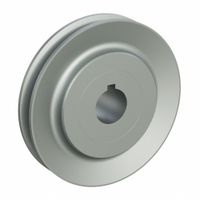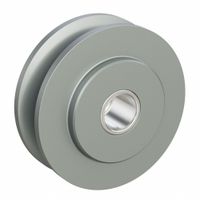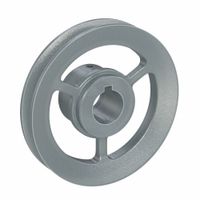Call +(254) 703 030 000 / 751 483 999 / 721 704 777
- Home
- Power Transmission
- Belts Pulleys
- V Belt Pulleys Idlers
.....Read More
Frequently Asked Questions
What is the difference between a V-belt pulley and an idler pulley?
A V-belt pulley and an idler pulley serve different functions in mechanical systems, particularly in belt-driven applications.
A V-belt pulley is a wheel with a grooved rim designed to fit a V-belt, which is a type of belt with a trapezoidal cross-section. The primary function of a V-belt pulley is to transmit power between shafts. It is typically mounted on a drive shaft and connected to a driven shaft, allowing for the transfer of rotational motion and torque. V-belt pulleys are integral to the operation of machinery, as they ensure efficient power transmission with minimal slippage due to the wedging action of the V-belt in the groove.
An idler pulley, on the other hand, is used to guide or tension a belt. It does not transmit power but instead supports the belt's path and maintains the correct tension to prevent slippage. Idler pulleys are often used in conjunction with V-belt systems to adjust the belt's tension or to redirect the belt's path around obstacles. They are typically mounted on a movable bracket or arm, allowing for adjustments to the belt's tension as needed. Idler pulleys can also help reduce vibration and noise in the system.
In summary, the key difference lies in their functions: V-belt pulleys are used for power transmission, while idler pulleys are used for belt tensioning and guidance.
How do I choose the right size V-belt pulley for my application?
To choose the right size V-belt pulley for your application, follow these steps:
1. **Identify Requirements**: Determine the power transmission requirements, including the horsepower (HP) and speed (RPM) of the motor and the driven equipment.
2. **Belt Type and Size**: Select the appropriate V-belt type (e.g., A, B, C, D) based on the power and speed requirements. Refer to manufacturer catalogs for belt specifications.
3. **Pulley Ratio**: Calculate the desired speed ratio between the driver and driven pulleys. This is the ratio of the RPM of the driver to the RPM of the driven component.
4. **Pulley Diameter**: Use the speed ratio to determine the diameters of the driver and driven pulleys. The formula is:
\[ \text{Driver Pulley Diameter} / \text{Driven Pulley Diameter} = \text{Driven RPM} / \text{Driver RPM} \]
5. **Center Distance**: Consider the center distance between the pulleys. Ensure it is sufficient to accommodate the belt length and tension requirements.
6. **Load and Torque**: Ensure the selected pulley can handle the load and torque. Check the manufacturer's specifications for maximum load capacity.
7. **Material and Construction**: Choose a pulley made from suitable materials (e.g., cast iron, steel, aluminum) based on environmental conditions and application requirements.
8. **Alignment and Balance**: Ensure the pulley is properly aligned and balanced to prevent vibration and premature wear.
9. **Installation Space**: Verify that there is enough space for installation and maintenance of the pulley system.
10. **Consult Manufacturer**: Refer to manufacturer guidelines and consult with their technical support for specific recommendations and compatibility.
By following these steps, you can select a V-belt pulley that meets your application's performance and durability needs.
What materials are V-belt pulleys typically made from?
V-belt pulleys are typically made from a variety of materials, each chosen for specific properties that suit different applications. Common materials include:
1. **Cast Iron**: Known for its durability and excellent wear resistance, cast iron is a popular choice for V-belt pulleys. It provides good machinability and is cost-effective for large-scale production. Cast iron pulleys are often used in industrial applications where heavy loads and high torque are involved.
2. **Steel**: Steel pulleys offer high strength and durability, making them suitable for heavy-duty applications. They can withstand high tension and are resistant to deformation under load. Steel is often used in environments where the pulley is exposed to harsh conditions or requires additional strength.
3. **Aluminum**: Lightweight and corrosion-resistant, aluminum pulleys are ideal for applications where weight reduction is crucial, such as in automotive or aerospace industries. Aluminum provides good thermal conductivity and is often used in applications where heat dissipation is important.
4. **Plastic/Polymer**: For lighter-duty applications, plastic or polymer pulleys are used. They are lightweight, resistant to corrosion, and can be cost-effective for certain applications. These materials are suitable for environments where noise reduction is important, as they tend to operate more quietly than metal pulleys.
5. **Composite Materials**: Composites, which combine different materials to enhance specific properties, are also used for V-belt pulleys. These materials can offer a balance of strength, weight, and corrosion resistance, making them suitable for specialized applications.
Each material offers distinct advantages and is selected based on factors such as load capacity, environmental conditions, cost, and specific application requirements.
How do I adjust the tension on a V-belt pulley system?
1. **Safety First**: Ensure the machine is turned off and unplugged. Wear appropriate safety gear.
2. **Access the Belt**: Remove any covers or guards to access the V-belt and pulleys.
3. **Inspect the Belt**: Check for wear, cracks, or fraying. Replace the belt if necessary.
4. **Locate the Adjustment Mechanism**: Identify the tension adjustment mechanism, which is usually a bolt or a set of bolts on the motor mount or an idler pulley.
5. **Loosen the Mounting Bolts**: Slightly loosen the bolts that secure the motor or the component with the adjustable pulley. This will allow movement to adjust tension.
6. **Adjust the Tension**:
- **For Motor Adjustment**: Slide the motor away from the other pulley to increase tension or towards it to decrease tension.
- **For Idler Pulley**: Adjust the idler pulley position to increase or decrease tension.
7. **Check the Tension**:
- Use a belt tension gauge if available.
- Alternatively, press down on the belt midway between the pulleys. A properly tensioned belt should deflect about 1/64 inch per inch of span length.
8. **Tighten the Bolts**: Once the desired tension is achieved, tighten the mounting bolts securely to hold the position.
9. **Recheck the Tension**: Ensure the tension remains correct after tightening. Adjust again if necessary.
10. **Reassemble and Test**: Replace any covers or guards. Plug in and test the machine to ensure smooth operation without slippage or excessive noise.
11. **Regular Maintenance**: Periodically check the belt tension and condition to ensure optimal performance and longevity.
What are the benefits of using a variable-pitch V-belt pulley?
A variable-pitch V-belt pulley offers several benefits:
1. **Speed Variation**: It allows for easy adjustment of the driven equipment's speed without changing the motor speed. This is particularly useful in applications requiring different operational speeds.
2. **Flexibility**: The ability to adjust the pitch diameter provides flexibility in system design and operation, accommodating various load conditions and performance requirements.
3. **Energy Efficiency**: By optimizing the speed of the driven equipment, energy consumption can be reduced, leading to cost savings and improved system efficiency.
4. **Reduced Wear and Tear**: Adjusting the pulley to the optimal speed can minimize mechanical stress on the system, reducing wear and extending the lifespan of both the belt and the equipment.
5. **Cost-Effective**: It eliminates the need for multiple pulleys or complex variable-speed drives, reducing initial setup costs and simplifying maintenance.
6. **Easy Installation and Adjustment**: Variable-pitch pulleys are generally easy to install and adjust, allowing for quick changes in operational parameters without extensive downtime.
7. **Improved Performance**: By fine-tuning the speed, the performance of the machinery can be optimized for specific tasks, enhancing productivity and output quality.
8. **Versatility**: Suitable for a wide range of applications, from industrial machinery to HVAC systems, providing a versatile solution for speed control.
9. **Noise Reduction**: Proper speed adjustment can lead to quieter operation, as the system can be tuned to run more smoothly and efficiently.
10. **Enhanced Control**: Offers precise control over the operational speed, which is crucial for processes requiring exact speed settings for optimal results.
How do I install a V-belt on a stepped pulley system?
1. **Safety First**: Ensure the machine is turned off and unplugged. Wear safety gloves and goggles.
2. **Access the Pulleys**: Remove any guards or covers to access the pulleys. Ensure the area is clear of debris.
3. **Loosen the Motor Mount**: If the motor is mounted on an adjustable base, loosen the bolts to allow the motor to slide and reduce tension on the belt.
4. **Remove the Old Belt**: If replacing an old belt, slide it off the pulleys. Note the path it takes for reference.
5. **Inspect Pulleys and Belt**: Check pulleys for wear or damage. Ensure the new V-belt is the correct size and type.
6. **Install the New Belt**: Place the new V-belt over the smallest step of the motor pulley and the corresponding step on the driven pulley. Ensure it sits properly in the grooves.
7. **Adjust Belt Tension**: Slide the motor back to increase tension. The belt should have about 1/2 inch of deflection with moderate pressure at the midpoint.
8. **Align the Pulleys**: Ensure the pulleys are aligned. Misalignment can cause premature wear or belt slippage.
9. **Secure the Motor**: Tighten the motor mount bolts to secure the motor in place.
10. **Check Belt Tracking**: Rotate the pulleys manually to ensure the belt tracks correctly and doesn’t slip off.
11. **Replace Guards**: Reinstall any guards or covers that were removed.
12. **Test the System**: Plug in and turn on the machine. Observe the belt operation for any issues like noise or slippage.
13. **Final Adjustments**: If necessary, make final adjustments to tension or alignment.
14. **Regular Maintenance**: Periodically check the belt for wear and tension to ensure optimal performance.
What maintenance is required for V-belt pulleys and idlers?
Maintenance of V-belt pulleys and idlers involves several key steps to ensure optimal performance and longevity:
1. **Regular Inspection**: Frequently check for wear and tear, misalignment, and any signs of damage on the belts, pulleys, and idlers. Look for cracks, fraying, or glazing on the belts and ensure pulleys and idlers are free from rust or corrosion.
2. **Alignment**: Ensure that the pulleys and idlers are properly aligned. Misalignment can cause excessive wear on the belts and reduce efficiency. Use alignment tools to check and adjust the alignment as necessary.
3. **Tension Adjustment**: Maintain the correct tension in the V-belts. Over-tensioning can lead to premature bearing failure, while under-tensioning can cause slippage and reduced power transmission. Use a tension gauge to measure and adjust the tension according to the manufacturer's specifications.
4. **Cleaning**: Keep the pulleys and idlers clean from dust, debris, and oil. Contaminants can cause slippage and wear. Use a dry cloth or brush to clean the surfaces regularly.
5. **Lubrication**: While V-belts themselves do not require lubrication, the bearings in idlers may need periodic lubrication. Use the appropriate type and amount of lubricant as specified by the manufacturer.
6. **Replacement**: Replace worn or damaged belts, pulleys, and idlers promptly to prevent further damage to the system. Always use parts that match the original specifications.
7. **Monitoring**: Implement a monitoring system to track the performance and condition of the belts and pulleys. This can help in early detection of potential issues and prevent unexpected downtime.
8. **Documentation**: Keep detailed records of maintenance activities, including inspections, adjustments, and replacements. This helps in tracking the maintenance history and planning future maintenance schedules.



